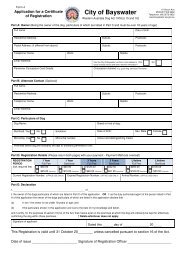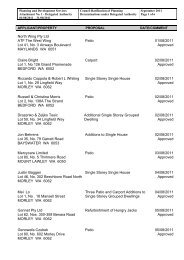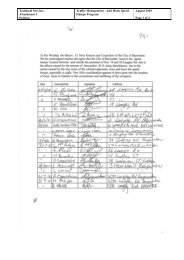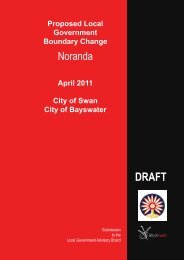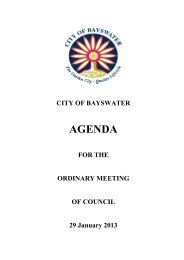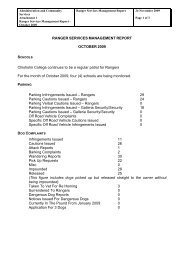Local Native Plants Guide - City of Bayswater
Local Native Plants Guide - City of Bayswater
Local Native Plants Guide - City of Bayswater
Create successful ePaper yourself
Turn your PDF publications into a flip-book with our unique Google optimized e-Paper software.
<strong>Local</strong> <strong>Native</strong> <strong>Plants</strong> <strong>Guide</strong><br />
31059 CiBay <strong>Plants</strong> Booklet.indd 1 5/3/10 2:56:19 PM
Contents<br />
Mayor’s message____________________________ 3<br />
Why grow local plants?_______________________ 4<br />
Where to begin __________________________________ 5<br />
Plant selection and planting out ___________________ 6<br />
Planting your local plants _________________________ 6<br />
List <strong>of</strong> specialist nurseries ____________________ 7<br />
Watering ___________________________________ 8<br />
When to water ________________________________ 8<br />
What irrigation to use __________________________ 8<br />
Pruning____________________________________ 9<br />
When to prune ________________________________ 9<br />
How to prune _________________________________ 9<br />
Tips for pruning _______________________________ 9<br />
Mulch ____________________________________ 10<br />
Why mulch? _________________________________ 10<br />
What makes a good mulch? ___________________ 10<br />
When to mulch? _____________________________ 10<br />
How much mulch? ___________________________ 10<br />
What to avoid? ______________________________ 10<br />
Fertilisers _________________________________ 11<br />
When to apply fertiliser _______________________ 11<br />
Best to use __________________________________ 11<br />
<strong>Local</strong> plant list __________________________ 12-15<br />
Cottage garden ____________________________ 16<br />
Cottage garden plant list ______________________ 17<br />
Water features _____________________________ 18<br />
Water feature plant list ________________________ 19<br />
Mediterranean gardens ______________________ 20<br />
Mediterranean plant list _______________________ 21<br />
Japanese style garden ______________________ 22<br />
Japanese plant list ___________________________ 23<br />
2 <br />
31059 CiBay <strong>Plants</strong> Booklet.indd 2 5/3/10 2:56:19 PM
<strong>City</strong> <strong>of</strong> <strong>Bayswater</strong> Mayor, Terry Kenyon JP<br />
Mayor’s message<br />
Welcome to the <strong>City</strong> <strong>of</strong> <strong>Bayswater</strong>’s Growing <strong>Local</strong> <strong>Native</strong><br />
<strong>Plants</strong> <strong>Guide</strong>.<br />
This guide is a collaboration <strong>of</strong> the most up to date<br />
information on recommended native landscaping plants<br />
in the <strong>City</strong> <strong>of</strong> <strong>Bayswater</strong>. You will find that the information<br />
provided in this book will help you not only achieve<br />
that dream garden but will also help in preserving the<br />
environment.<br />
We have included tips that will make having a native<br />
garden easy. When the information is at your fingertips it<br />
makes the process simpler and will place the garden <strong>of</strong><br />
your dreams within reach.<br />
So I suggest, sit down with a cup <strong>of</strong> c<strong>of</strong>fee or tea and<br />
digest the invaluable information this guide has to <strong>of</strong>fer.<br />
Then get out your gardening gloves and get to work on a<br />
garden that reflects your lifestyle.<br />
Hope you enjoy it!<br />
<strong>City</strong> <strong>of</strong> <strong>Bayswater</strong> Mayor, Terry Kenyon JP<br />
3<br />
31059 CiBay <strong>Plants</strong> Booklet.indd 3 5/3/10 2:56:20 PM
Why grow local plants?<br />
<br />
<br />
4<br />
It’s important to understand why it’s better to plant<br />
local plants before you embark on planting your dream<br />
garden.<br />
The planting <strong>of</strong> exotic plants in your garden can lead<br />
to a variety <strong>of</strong> problems. Firstly, they require more water<br />
which is increasingly a concern in Australia. Secondly<br />
they require more fertiliser which enters groundwater and<br />
street drainage, contributing to toxic algal blooms in the<br />
Swan River and wetlands.<br />
They can also become environmental weeds as they<br />
can spread into native bushland and compete with our<br />
native species. <strong>Native</strong> plants unlike non-natives occur in<br />
local bushlands around <strong>Bayswater</strong> and so rarely become<br />
a problem.<br />
<strong>Native</strong> gardens use less water, need less fertilisers and<br />
don’t invade other areas <strong>of</strong> bushland. Not only will you<br />
have a colourful garden all year round but you’ll lessen<br />
your water bill and feel good about doing something for<br />
the environment.<br />
Many <strong>of</strong> our native plants also provide food and habitat for<br />
native birds, insects, butterflies and frogs while providing<br />
vegetation islands for these animals to rest.<br />
So not only do local, native plants stop environmental<br />
degradation but they also increase biodiversity in your<br />
suburb!<br />
31059 CiBay <strong>Plants</strong> Booklet.indd 4 5/3/10 2:56:21 PM
Where to begin<br />
Here are some handy tips to think about when designing<br />
your garden:<br />
try drawing the colours you want on graph paper to<br />
give you a good idea <strong>of</strong> the colours and types <strong>of</strong> plants<br />
you want, where you want to plant them and how the<br />
result may look;<br />
rid yourself <strong>of</strong> weeds before you plant and mulch.<br />
Try not to plant larger plants near fences and walls,<br />
because they can be damaged as the plants grow<br />
larger;<br />
most plants now come in different forms, so remember<br />
to ask about dwarf and groundcover varieties <strong>of</strong> your<br />
favourite plants to better fit your garden;<br />
for all year round colour, select plants that flower in<br />
different seasons. Ask your nursery for plants with<br />
different coloured foliage, such as Agonis flexuosa<br />
‘Burgundy’ which has deep red leaves, to bring more<br />
colour to your garden; and<br />
don’t be afraid to be creative, mix up species, colours<br />
and sizes in differing numbers for a natural yet<br />
effective look.<br />
<br />
5<br />
31059 CiBay <strong>Plants</strong> Booklet.indd 5 5/3/10 2:56:21 PM
Plant selection and planting out<br />
These tips will help you in selecting the types <strong>of</strong> plants you would like in your garden:<br />
go for smaller plants in larger pots as they won’t be root bound and more likely to survive<br />
when you put them in the ground. If you’re looking for a more instant effect buy more<br />
mature plants;<br />
read the label on the plants as they tell you how much water and sunlight it will need as well as how<br />
big it will grow;<br />
take advantage <strong>of</strong> the winter rains and plant in April through August. <strong>Plants</strong> will get plenty <strong>of</strong> water<br />
and have time to establish before the spring growing season and survive the summer; and<br />
don’t be afraid to ask your local nursery for advice. Alternatively try the North Metro Conservation<br />
Group or Environment House as they are a bundle <strong>of</strong> knowledge on local plants.<br />
Planting your local plants<br />
Consider the following when planting your native plants:<br />
set out your plants in their pots where you want them to be, keep shuffling them until you have the<br />
look you desire.<br />
give the plant, the hole and the soil around it, a good water before planting. Try adding a wetting<br />
agent to improve water retention, and a little bit <strong>of</strong> low phosphorus fertiliser;<br />
dig a hole that is a bit larger than the pot. Take the plant from its pot and gently loosen the roots<br />
before placing it in the middle <strong>of</strong> the hole and carefully fill in with soil;<br />
6<br />
<br />
<br />
gently but firmly pat the soil around the plant concentrating on the area around the stem.<br />
The plant should be slightly lower than the surrounding soil, forming a small depression around<br />
its stem so the water is directed towards the roots.<br />
finish <strong>of</strong>f with a 5 cm deep and 20 cm wide layer <strong>of</strong> mulch around the plant base (try not to have the<br />
mulch too close to the stem because it can encourage rotting).<br />
31059 CiBay <strong>Plants</strong> Booklet.indd 6 5/3/10 2:56:22 PM
List <strong>of</strong> specialist nurseries that sell local plants<br />
Here are a number <strong>of</strong> nurseries where you will be able to buy the plants you need. The <strong>City</strong> <strong>of</strong> <strong>Bayswater</strong><br />
doesn’t necessarily endorse these nurseries, and alternatives are available in the phone book.<br />
Nursery Street Suburb Phone Fax<br />
APACE Nursery 1 Johanna Street North Fremantle 9336 1262 9430 5729<br />
Australian <strong>Native</strong> Nursery Group 141 King Road Oakford 9525 1324 9525 4703<br />
Boola Wongin Nursery 619 Armadale Road Forestdale 9397 0160 9397 1430<br />
Carramar Coastal Nursery Lot 5 Mandurah Road Secret Harbor 9524 1227 9524 1777<br />
Environment House 61 Eighth Avenue Maylands 9271 4488 9271 9005<br />
Lullfitz Nursery Caporn Street Wanneroo 9405 1607 9306 2933<br />
Men Of The Trees Corner Amherst Road/ Hazelmere 9250 1888 9250 2735<br />
Stirling Crescent<br />
Muchea Tree Farm Lot 214 Archibald Street Muchea 9571 4090 9571 4297<br />
<strong>Native</strong> Flora Technologies 30 Malvern Street West Swan 9250 3491 9250 3491<br />
9377 0444<br />
Zanthorrea Nursery 155 Watsonia Road Maida vale 9454 6260 9454 4540<br />
Also check out www.bayswater.wa.gov.au for more native nurseries<br />
7<br />
31059 CiBay <strong>Plants</strong> Booklet.indd 7 5/3/10 2:56:22 PM
Watering<br />
When to water<br />
Choosing local plants reduces water wastage.<br />
It’s a great idea to use local plants because they are<br />
suited to Perth’s climate and require little summer<br />
watering. While they are establishing however they will<br />
require some watering. This is also true during extended<br />
dry periods at any time <strong>of</strong> year.<br />
Water a couple <strong>of</strong> times a week in the first week <strong>of</strong> planting.<br />
Keep this up during the summer months for the first year<br />
to give your plants a kick start. More established plants<br />
won’t need much water, but if they start to look stressed<br />
or if a heat wave hits, a ‘one <strong>of</strong>f’ on your designated<br />
watering day will be enough to see them through.<br />
The best time to water would be in the morning, but be sure<br />
not to over water as this could lead to rotting, diseases<br />
and shallow root growth, as well as the encouragement<br />
<strong>of</strong> weeds. If water repellence occurs, you may need to<br />
apply a wetting agent.<br />
What irrigation to use<br />
It’s important to choose the correct irrigation methods to<br />
get the maximum benefit from your garden.<br />
Methods where the water is directed straight towards the<br />
roots are best, like adjustable dripper or trickle systems<br />
and subsurface irrigation. For plants with a high water<br />
demand, simply use a high flow rate dripper.<br />
Another option is to use grey water from the everyday<br />
running <strong>of</strong> your household. Grey water is waste water from<br />
your household such as the shower and laundry.<br />
Wherever this system is used it’s important the grey water<br />
is disposed <strong>of</strong> below the ground and a licence is obtained<br />
from your local Council’s Health Section so is doesn’t<br />
cause a health hazard. For more information contact<br />
the <strong>City</strong> <strong>of</strong> <strong>Bayswater</strong> Environmental Health Section on<br />
9272 0648.<br />
8 <br />
31059 CiBay <strong>Plants</strong> Booklet.indd 8 5/3/10 2:56:22 PM
Pruning<br />
When to prune<br />
Your best time to prune is in late spring or early summer.<br />
Pruning in winter or mid summer should be avoided because this<br />
can lead to extensive die back in your plants. Young plants should<br />
be pruned lightly and regularly while older plants can handle more<br />
extensive pruning and love a good trim.<br />
How to prune<br />
After the plant has finished flowering, cut the stems just behind the<br />
seed pod to prune new season growth. For old wood just prune the<br />
centre <strong>of</strong> the plant and leave the younger growth<br />
on the outsides.<br />
Tips for pruning:<br />
cut <strong>of</strong>f the whole branch cleanly ly at the joint leaving a flat edge;<br />
remove<br />
low<br />
branches to make weeding e easier; e and<br />
the s<strong>of</strong>ter wooded plants aren’t as tough as<br />
the hardier woody<br />
plants, so they should only be pruned lightly.<br />
Hot Tip!<br />
Tough love<br />
To help prevent black ink disease, be brutal and cut back<br />
Kangaroo Paws after flowering each year. They’ll thank you for it<br />
in the long run!<br />
9<br />
31059 CiBay <strong>Plants</strong> Booklet.indd 9 5/3/10 2:56:23 PM
Mulch<br />
Why mulch?<br />
Adding suitable mulch to your garden after planting not<br />
only helps the soil to retain moisture and keep your plants<br />
cooler, but it also reduces the number <strong>of</strong> weeds in your<br />
garden and therefore the amount <strong>of</strong> weeding you have<br />
to do. The best mulches are a mixture <strong>of</strong> different plant<br />
materials <strong>of</strong> different sizes.<br />
What makes a good mulch?<br />
The best mulch is the one that if you walk on it without<br />
shoes, it hurts your feet. Coarse material is best, like the<br />
natural leaf litter from your garden.<br />
When to mulch?<br />
All mulches break down over time so you will need to<br />
replace it every spring or early summer.<br />
How much mulch?<br />
To aid water retention, create a circular depression around<br />
the plant in a 10 cm thick layer <strong>of</strong> suitable mulch.<br />
What to avoid?<br />
Applying mulch too close to the plant stem can encourage<br />
disease and rotting. Not a desirable outcome!<br />
Mulches made from exotic species and s<strong>of</strong>t leaved plants<br />
can degrade too quickly and release nutrients into the soil<br />
too fast for WA plants.<br />
Some commercial mulches are higher in nitrogen and<br />
phosphorus and not suitable for local WA plants. They<br />
are usually already composted and are more a soil<br />
conditioner rather than a mulch. Look for native plant or<br />
low phosphorus fertilisers.<br />
10<br />
31059 CiBay <strong>Plants</strong> Booklet.indd 10 5/3/10 2:56:23 PM
Fertilisers<br />
<strong>Native</strong> plants evolved to the low nutrient levels in most<br />
<strong>of</strong> <strong>Bayswater</strong>’s soils. This is why exotic plants need<br />
heaps more fertilisers than natives.<br />
<strong>Native</strong> plants can’t handle traditional fertilisers because<br />
they don’t like high nutrient levels, in particular,<br />
phosphorus.<br />
To keep your garden looking stunning, add a little<br />
native fertiliser and follow the instructions on the bag.<br />
Remember excess nutrients are a waste and only cause<br />
algal blooms in our waterways.<br />
When to apply fertiliser<br />
The best option is to apply the fertilisers to the bottom<br />
<strong>of</strong> the hole when planting. Only apply fertiliser during<br />
the growing season and over the root zone when the<br />
plant shows signs <strong>of</strong> nutrient deficiencies.<br />
Hot Tip!<br />
Not all bugs are bad<br />
For a more organic solution try seaweed fertiliser or<br />
fish emulsion to encourage more healthy microbial<br />
activity in your soil. It will also help your plants to<br />
grow and fight <strong>of</strong>f diseases.<br />
<br />
<br />
11<br />
31059 CiBay <strong>Plants</strong> Booklet.indd 11 5/3/10 2:56:24 PM
<strong>Local</strong> Plant List(Coastal & Eastern)<br />
Botanical Name Common/Nyoongar Name Height (m) Flower Colour Flower Time<br />
Trees & Small Trees<br />
Allocasuarina fraseriana Sheoak/Kondil 15 Brown May - Oct<br />
Banksia attenuata Candle Banksia/Piara 5 to 8 Yellow Sep - Oct<br />
Banksia grandis Bull Banksia/Pulgaria 10 Yellow Sep - Dec<br />
Banksia ilicifolia Holly-leaf Banksia 10 Red & cream Mar - Jan<br />
Banksia littoralis Swamp Banksia 10 Pale yellow March - Aug<br />
Banksia menziesii Firewood Banksia 10 Red & silver Feb - Aug<br />
Banksia prionotes Acorn Banksia 10 Bright orange March - May<br />
Eucalyptus ficifolia Red Flowering Gum 8 Red Dec - May<br />
Eucalyptus lane-poolei Salmon White Gum 12 to 15 Creamy-white Jan - Sep<br />
Eucalyptus rudis Flooded Gum to 20 Creamy-white Aug<br />
Eucalyptus todtiana Coastal Blackbutt/Prickly Bark 9 to 16 Creamy-white Feb<br />
Nuytsia floribunda Christmas Tree to 10 Bright orange Oct - Jan<br />
Paraserianthes lophantha Albizia 10 Greenish-yellow Aug - Feb<br />
Xylomelum occidentale Woody Pear to 8 White Dec - Feb<br />
Shrubs (3 to 5m)<br />
Acacia rostellifera Summer-scented Wattle 2 to 5 Yellow Aug - Oct<br />
Acacia saligna Kudjong 5 Yellow Aug - Oct<br />
Actinostrobis pyramidalis Swamp Cypress 3 Brown Aug - Nov<br />
Adenanthos cygnorum Common Woollybush 2 to 4 Red Sep - Feb<br />
Conospermum triplinervium Tree Smokebush 5 Grey Aug - Nov<br />
Hakea bucculenta Red Pokers 5 Red Aug - Sept<br />
Hakea prostrata Harsh Hakea 3 White Aug - Nov<br />
Hakea victoria Royal Hakea 3 White Jun - Jul<br />
Oxylobium lineare River Pea 3 Red, Yellow Sep - Jan<br />
Shrubs (1 to 3m)<br />
Acacia dentifera 3 Golden Aug - Nov<br />
Acacia pulchella Prickly Moses 2 Yellow Jun - Oct<br />
Adenanthos obovatus Basket Flower 2 Scarlet, Orange Aug - Nov<br />
12<br />
31059 CiBay <strong>Plants</strong> Booklet.indd 12 5/3/10 2:56:24 PM
Botanical Name Common/Nyoongar Name Height (m) Flower Colour Flower Time<br />
Beaufortia squarrosa Sandplains Brush Myrtle/Puno 2 Red Jan - Apr<br />
Calothamnus quadrifidus One sided Bottle Brush/Kwowdjard 1 to 2 Red Aug - Dec<br />
Calothamnus sanguineus Silky-leaved Blood Flower/Pin-dak 2 Blood Red Mar - Oct<br />
Conospermum incurvum Plume Smokebush 0.4 to 1 White-grey Jul - Nov<br />
Dampiera teres Terete-leaved Dampiera 0.2 to 0.6 Blue Aug - Nov<br />
Darwinia citriodora Lemon Scented Myrtle 2 Yellow, Red Jul - Dec<br />
Dryandra armata Prickly Dryandra 2 Yellow Jun - Nov<br />
Eremaea pauciflora Orange-flowered Eremaea 1.5 to 2 Orange Sep - Dec<br />
Eremaea purpurea Purple-flowered Eremaea 2 Pink-purple Oct - Feb<br />
Grevillia obtusifolia 0.5 to 2 Red Sep - Oct<br />
Hakea lissocarpha Honey Bush 3 White-yellow, Pink Jun - Sep<br />
Hakea ruscifolia Candle Hakea 3 White Dec - Mar<br />
Lambertia multiflora Many-flowered Honeysuckle 3 Yellow Jun - Dec<br />
Macrozamia riedlei Zamia Palm/Djiridji 3 Red Sep - Oct<br />
Melaleuca acerosa Coast Honey Myrtle 1 Cream Sep - Dec<br />
Melaleuca conothamnoides 0.3 to 1.5 Pink-purple Apr - Jan/Sep - Nov<br />
Melaleuca radula Graceful Honey Myrtle 3 Pink, Mauve Sep - Nov<br />
Persoonia saccata Thread-leaf Snottygobble 0.2 to 1.5 Yellow Jul - Jan<br />
Xanthorhoea preissii Grasstree/Palga 3 White Nov - Jan<br />
Shrubs (Less than 1m)<br />
Acacia lasiocarpa Dune Moses/Panjang 0.5 to 1 Yellow Jun - Aug<br />
Acacia preissiana 0.05 to 0.35 Yellow Dec - Jan<br />
Acacia stenoptera Narrow-winged Wattle 0.3 to 1 Creamy-yellow May - Sep<br />
Acacia willdenowiana Grass Wattle 0.3 to 0.6 White, Yellow Jun - Oct<br />
Actinostrobus acuminatus Dwarf Cypress 0.3 to 0.75 Brown Oct - Dec<br />
Andersonia lehmanniana 0.15 to 0.6 White, Pink-purple May - Sep<br />
Baeckea camphorosmae Camphor Myrtle 1 White, Pink May - Feb<br />
Beaufortia elegans 1 Purple, Pink Nov - Feb<br />
Beaufortia purpurea 1 Purple Oct - Jan<br />
Boronia crenulata Aniseed Boronia 1 Pale Red Aug - Oct<br />
13<br />
31059 CiBay <strong>Plants</strong> Booklet.indd 13 5/3/10 2:56:24 PM
14<br />
<strong>Local</strong> Plant List(Coastal & Eastern) cont.<br />
Botanical Name Common/Nyoongar Name Height (m) Flower Colour Flower Time<br />
Bossiaea eriocarpa Common Brown Pea 0.2 to 1 Brown & Yellow Jul - Oct<br />
Calytrix flavescens Summer Starflower 0.3 to 0.8 Yellow Nov - Jan<br />
Calytrix fraseri Pink Summer Calytrix 0.6 to 1 Pink, Purple All Year<br />
Chorizema dicksonii Yellow-eyed Flame-pea 1 Orange-red & Yellow Aug - Oct<br />
Chorizema ilicifolium Holly flame pea 0.75 Red & Yellow Jul - Aug<br />
Dampiera linearis Common Dampiera 0.15 to 0.6 Indigo Jul - Nov<br />
Darwinia citriodora Lemon Scented Myrtle 2 Yellow, Red Jul - Dec<br />
Dryandra lindleyana Couch Honeypot/Pudjaun Low Gold May - Sep<br />
Eremophila glabra Tarbush 0.5 to 1 Orange Mar - Dec<br />
Gompholobium tomentosum Hairy Yellow Pea 0.3 to 1 Yellow Aug - Dec<br />
Grevillea bipinnatifida Fuchsia Grevillea 0.3 to 1 Dull Red-Orange, Red Mar - Nov<br />
Grevillea pressii Sea Spray to 1m Red Jun - Sep<br />
Grevillea thelmanniana Spider-net Grevillea 0.4 to 1 Red May - Sep<br />
Grevillea wilsonsii Wilson’s Grevillea 0.5 to 1 Bright Red May - Nov<br />
Hakea myrtoides Myrtle Hakea 1 Dark Pink Jul - Aug<br />
Hibbertia hypericoides Buttercups 0.75 Brilliant yellow May - Oct<br />
Hibbertia racemosa Stalked Guinea-flower 0.1 to 0.75 Yellow Jul - Nov<br />
Hovea pungens Devil’s Pins/Puyenak 2 Purple Jun - Nov<br />
Hovea trisperma Common Hovea 0.1 to 0.7 Purple Jun - Sep<br />
Hypocalymma angustifolium Coconut Ice 0.75 White or pink-tinged Jul - Oct<br />
Hypocalymma robustum Swan River Myrtle 1 Pale Deep-pink Jul - Oct<br />
Isopogon dubius Rose Conebrush 1 Pink Jul - Oct<br />
Isotropis cuneifolia Granny’s Bonnets 0.05 to 0.3 Yellow & Red Aug - Oct<br />
Jacksonia sericea Waldjumi 0.6 Orange Dec - Feb<br />
Labichea punctata Lance-leaved Cassia 1 Yellow Jul - Oct<br />
Melaleuca scabra Rough Honey-myrtle 1 Pink-purple Sep - Dec<br />
Melaleuca trichophylla 0.15 to 1 Pink-purple Nov - Jan<br />
Petrophile linearis Pixie-mops 0.2 to 1 Pink, mauve Sep - Nov<br />
Petrophile macrostachya 1 Yellow Aug - Nov<br />
Pimelea rosea Rose Banjine 1 Pale Deep-pink Aug - Nov<br />
31059 CiBay <strong>Plants</strong> Booklet.indd 14 5/3/10 2:56:24 PM
Botanical Name Common/Nyoongar Name Height (m) Flower Colour Flower Time<br />
Pimelea sulphurea Yellow Banjine 0.15 to 0.7 Yellow Oct - Nov<br />
Scaevola calliptera 0.1 to 0.4 Blue Sep - Jan<br />
Sphaerolobium medium 0.1 to 0.6 Yellow-Orange-Red Aug - Nov<br />
Verticordia densiflora Bushy Featherflower 1 Pink, White Nov - Jan<br />
Verticordia huegalii Variegated Featherflower 0.6 Cream, Yellow Aug - Oct<br />
Verticordia plumosa Plumed Featherflower 1 Pink Sep - Dec<br />
Perennial Herbs<br />
Anigozanthos humilis Catspaw 0.1 to 1 Orange Aug - Oct<br />
Anigozanthos manglesii Kangaroo Paw/Kurulbrang 1 Red & Green Sep - Nov<br />
Anigozanthos viridis Green Kangaroo Paw 1 Green Sep - Nov<br />
Austrostipa flavescens Tall Speargrass 0.2 to 1.2 Silver Sep - Oct<br />
Austrostipa semibarbata Bearded Speargrass 0.3 to 0.1 White hairy Aug - Nov<br />
Chamaescilla corymbosa Blue Squill 0.05 to 0.4 Pink Aug - Oct<br />
Conostylis aculeata Grey Cottonheads 0.4 Yellow Aug - Sep<br />
Conostylis candicans Spiny Cottonheads 0.4 Yellow Sep - Nov<br />
Conostylis setigera Bristly Cottonheads 0.4 Yellow Sep - Oct<br />
Dianella revoluta Blueberry Lilly/<strong>Native</strong> flax 1 Purple Sep - Jan<br />
Neurachne alopecuriodes Foxtail Mulga-grass 1 Grey Aug - Nov<br />
Orthrosathus laxus Morning Iris 0.15 to 0.55 Blue Aug - Nov<br />
Patersonia occidentalis Purple Flag/Kom-ma 0.5 to 0.8 Purple Sep - Oct<br />
Climbers & Groundcovers<br />
Hardenbergia comptoniana <strong>Native</strong> Wisteria Climber Purple Jun - Sep<br />
Hemiandra pungens Snakebush Climber Mauve All Year<br />
Kennedia coccinea Coral Vine Climber Red-yellow Jul - Nov<br />
Kennedia nigricans Black Coral Pea Climber Black & Yellow Jul - Nov<br />
Kennedia prostrata Running Postman Low Red Aug - Nov<br />
Pronaya fraseri Pronaya Climber Pale Mauve Dec - Feb<br />
Sollya heterophylla Australian Bluebell Low & climber Sky Blue Oct - Feb<br />
15<br />
31059 CiBay <strong>Plants</strong> Booklet.indd 15 5/3/10 2:56:24 PM
16 <br />
Cottage garden<br />
Everyone loves that ‘cottage garden’ look.<br />
A cottage garden is a mixture <strong>of</strong> fast growing native annuals and<br />
herbaceous perennials, with winding pathways and peaceful<br />
alcoves.<br />
Follow these few simple guidelines to ensure successful cottage<br />
garden planting:<br />
your garden beds should not be formally structured, mix it<br />
up a little and plant randomly. Remember if it isn’t the look<br />
you desire, you can always move them around;<br />
self seeding plants will mean your garden will develop<br />
without continual planting;<br />
scented plants will give a lingering fragrance over the garden<br />
and add to the effect;<br />
create focal points by placing different colour foliaged plants<br />
around benched, arches and statues;<br />
cottage gardens are all about the blooms, so replace some<br />
lawn with garden beds;<br />
cover unattractive sights such as old sheds and boring walls<br />
with climber covered lattice and if you’re feeling adventurous<br />
run a climber up your arches; and<br />
arches, arbors, lattice, picket fences, rustic ornaments,<br />
garden furniture, pots, statues and ornaments will all look at<br />
home in your cottage garden.<br />
31059 CiBay <strong>Plants</strong> Booklet.indd 16 5/3/10 2:56:24 PM
Cottage garden plant list<br />
Try the below plants to achieve that ‘cottage’ look.<br />
Patersonia occidentalis Leschenaultia biloba Anigozanthos manglesii<br />
Tree<br />
Common name<br />
Little strappy plants<br />
Common name<br />
Eucalyptus ficifolia<br />
Red flowering gum<br />
Anigozanthos manglesii<br />
Kangaroo paws<br />
Eucalyptus victrix<br />
Conostylis candicans<br />
Spiny Cottonheads<br />
Shrub<br />
Acacia lasiocarpus<br />
Dune Moses<br />
Orthrosanthus<br />
laxus/multiflorus<br />
Morning Iris<br />
Eremea purpurea/elegans<br />
Eremophila calorhabdos<br />
Pimelea ferruginea<br />
Small shrub<br />
Dryandra nivea<br />
Red rod<br />
Honeypot Dryandra<br />
Climber<br />
Hardenbergia<br />
comptoniana<br />
Groundcover<br />
Adenanthos cuneatus<br />
(low groundcover form)<br />
<strong>Native</strong> Wisteria<br />
Coastal Jugflower<br />
Leschenaultia biloba<br />
Blue Leschenaultia<br />
Eremophila glabra<br />
Kalbarri carpet<br />
Hemiandra pungens Snakebush<br />
Melaleuca pentagona Little Penta Pimelea ferruginea<br />
17<br />
31059 CiBay <strong>Plants</strong> Booklet.indd 17 5/3/10 2:56:25 PM
Water features<br />
Water features always lift the look <strong>of</strong> a garden and can<br />
really create a great ‘feel’.<br />
A water feature can be as large or as small as you want or<br />
as space allows. Your water feature can be anything from<br />
water slowly spilling over the edges <strong>of</strong> an ornamental pot<br />
to a cascading fountain.<br />
Most people don’t realise that many species adapted<br />
to Perth soils are also great for water gardens. Ask your<br />
nursery about native sedges.<br />
Not only is a water feature a great element in your design,<br />
but it also attracts birds and frogs into your garden.<br />
18<br />
31059 CiBay <strong>Plants</strong> Booklet.indd 18 5/3/10 2:56:26 PM
Water feature plant list<br />
Here are some native species that are great for water gardens.<br />
Dianella revoluta Juncus kraussii Acacia pulchella<br />
Tree<br />
Melaleuca priessiana<br />
Melaleuca rhaphiophylla<br />
Shrubs<br />
Acacia pulchella<br />
Conostylis sitergia<br />
Dampiera linearis<br />
Dianella revoluta<br />
Sedges and rushes<br />
Baumea juncea<br />
Ficinia nodosa<br />
Juncus kraussii<br />
Juncus pallidus<br />
Common name<br />
Moonah<br />
Swamp Paperbark<br />
Prickly Acacia<br />
Bristly Cottonhead<br />
Common Dampiera<br />
Blue Berry Lilly<br />
Bare Twig Rush<br />
Knotted Club Rush<br />
Shore Rush<br />
Pale Rush<br />
Ficinia nodosa<br />
19<br />
31059 CiBay <strong>Plants</strong> Booklet.indd 19 5/3/10 2:56:26 PM
Mediterranean gardens<br />
The Mediterranean garden is a great garden for<br />
entertaining in Perth’s hot summers.<br />
This design is a mixture <strong>of</strong> courtyards surrounded by<br />
planter beds filled with bright flowers. You can use some<br />
statues, bright ornamental pots or garden arches to add a<br />
bit <strong>of</strong> flair to your design.<br />
20 <br />
31059 CiBay <strong>Plants</strong> Booklet.indd 20 5/3/10 2:56:27 PM
Mediterranean garden plant list<br />
Below is a list <strong>of</strong> plants you may want to have a look at if you<br />
like the idea <strong>of</strong> a Mediterranean garden.<br />
Hypocalymma<br />
robustum<br />
Kennedia prostrata<br />
Eremophila glabra<br />
Tree<br />
Common name<br />
Groundcover / Climber<br />
Eucalyptus torquata<br />
Coral Gum<br />
Eremophila glabra<br />
Tarbush<br />
Eucalyptus victrix<br />
Shrub<br />
Acacia lasiocarpa<br />
Dune Moses<br />
Hardenbergia<br />
comptoniana<br />
Kennedia prostrata<br />
<strong>Native</strong> Wisteria<br />
Running Postman<br />
Anigozanthos manglesii<br />
Conostylis candicans<br />
Kangaroo Paw<br />
Spiny Cottonheads<br />
Perennial herb<br />
Dianella revoluta<br />
Blueberry Lily<br />
Eremophila calorhabdos Red Rod<br />
Hypocalymma robustum Swan River Myrtle<br />
Macrozamia reidlei<br />
Xanthorrhea sp<br />
Zamia Palm<br />
Grass Tree<br />
Conostylis candicans<br />
21<br />
31059 CiBay <strong>Plants</strong> Booklet.indd 21 5/3/10 2:56:28 PM
Japanese style garden<br />
Why not add some spirituality to your garden?<br />
The Japanese style garden draws influences from Shinto,<br />
Buddhist and Taoist philosophies to bring a sense <strong>of</strong><br />
spirituality to the garden.<br />
Rocks are positioned first because they change the<br />
least and represent stability in the garden. Rocks should<br />
be <strong>of</strong> similar colour, texture and form. Pebbles are also<br />
a regular feature and are used to represent the flow <strong>of</strong><br />
water and continuity <strong>of</strong> life. They can also be used to form<br />
pathways.<br />
Small bamboo water features like a deer scarer are<br />
common in a Japanese garden and bring the sound <strong>of</strong><br />
tranquillity to the space, as well as mark the passing <strong>of</strong><br />
time.<br />
Gazebos are a good way to enjoy and observe the garden<br />
in all seasons, while statues <strong>of</strong> lions are placed at the<br />
entrance to a garden to guard against intruders.<br />
The common rule <strong>of</strong> the Japanese garden is ‘less is more!”<br />
22<br />
31059 CiBay <strong>Plants</strong> Booklet.indd 22 5/3/10 2:56:28 PM
Japanese garden plant list<br />
Below is a list <strong>of</strong> plants that may inspire your creativity<br />
when choosing plants.<br />
Grevillea obtusifolia<br />
Hemiandra pungens<br />
Xanthorrhoea preissii<br />
Tree<br />
Agonis flexuosa<br />
Pittosporum<br />
phylliraeoides<br />
Common name<br />
Peppermint ‘Burgundy’<br />
Weeping Pittosporum<br />
Shrub<br />
Banksia blechnifolia<br />
Hakea bucculenta<br />
Xanthorrhoea sp<br />
Groundcover / Climber<br />
Grevillea obtusifolia<br />
Hemiandra Pungens<br />
Perennial Herb<br />
Dianella revoluta<br />
Ficinia nodosa<br />
Red Poker<br />
Grass Tree<br />
Gin Gin Gem<br />
Snakebush<br />
Blueberry Lily<br />
Hakea bucculenta<br />
23<br />
31059 CiBay <strong>Plants</strong> Booklet.indd 23 5/3/10 2:56:29 PM
Where to from here?<br />
The <strong>City</strong> <strong>of</strong> <strong>Bayswater</strong> hopes you have enjoyed the booklet and have found<br />
the information useful. With all this talk about the world’s environmental<br />
problems, it can all seem hard to know where you can help. This book<br />
represents the ways in which you can begin to s<strong>of</strong>ten your eco footprint by<br />
increasing biodiversity in your garden and stopping algal blooms, all while<br />
having a beautiful garden with Australian values.<br />
For more information on the booklet visit the <strong>City</strong>’s website<br />
www.baywater.wa.gov.au under the Environment section for updates<br />
on garden designs, nurseries recommended books, plant photos and<br />
plant facts.<br />
<strong>City</strong> <strong>of</strong> <strong>Bayswater</strong><br />
61 Broun Avenue<br />
Morley WA 6062<br />
Tel: (08) 9272 0622<br />
Fax: (08) 9272 0665<br />
Email: mail@bayswater.wa.gov.au<br />
Website: www.bayswater.wa.gov.au<br />
This book has been produced with 100% recycled paper.<br />
31059 CiBay <strong>Plants</strong> Booklet.indd 24 5/3/10 2:56:30 PM



